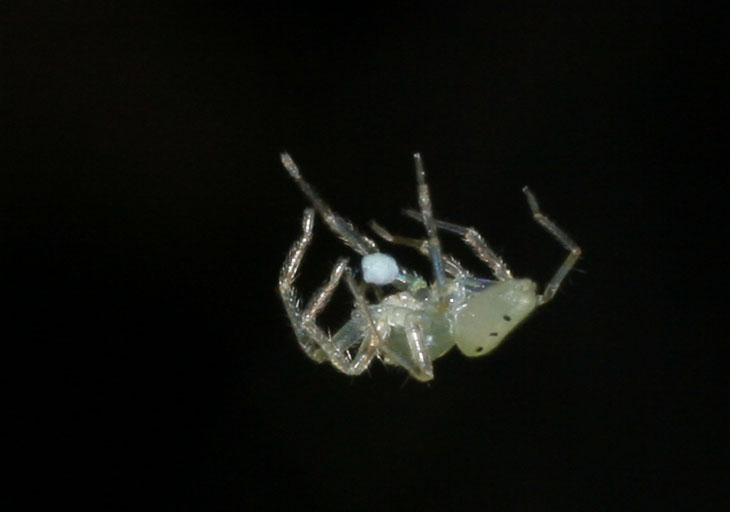
I’m not putting a lot of faith into this, considering the fluctuations of weather we’re already prone to here, plus the wildly unorthodox winter last year, but the first signs of spring are visible, and I’m lucky enough to have students who want to take advantage of it. Yesterday, the weather was fantastic but I didn’t get the chance to do anything about it, so I went out last night instead, seeking out some areas where the chorus frogs might be found dependably for photos. While unable to catch a glimpse of any, even though they were still sounding off as the temperature dropped to 10°c (50°f,) I saw a ridiculous number of spiders, mostly from their eyes reflecting the bright LED headlamp I was wearing. The one above was suspended over the trail, apparently gathering up webbing; I’ve heard that spiders often recycle their web by eating it, so I suspect this is what was going on, but did not watch long enough to confirm this. This image is at almost full-resolution, handheld and aimed by the light of the headlamp (which was getting blocked by the flash unit atop the camera,) so it was far from the ideal setup for doing macro work, and it wasn’t until I got back that I realized it was probably a magnolia green jumping spider (Lyssomanes viridis.) I wish I’d identified it then, because I would have brought it back to do more anatomical shots, and perhaps try to establish a presence of them around the place.
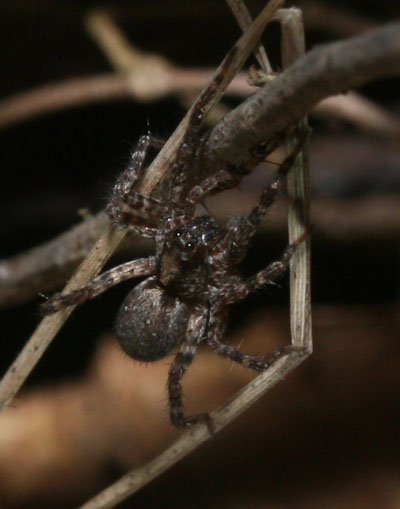 Betrayed by its eyes, this unidentified spider at least gave me more of an interesting pose when I went in close – most just remained in place on the ground as if pinned on display. The reflection must come from a very narrow angle between light and receiver (which means your eye, or the camera lens,) so the reflection effect is not visible in the image, and in fact very hard to get when close enough to see the details of the spider at all. A bright light may show a starburst of blue-green down on the ground (and occasionally on weeds, tree trunks, overhead branches, and even out onto the water,) a few meters away, which will disappear as you draw closer. Usually, this is just because the reflection angle has gotten too great, and keeping an eye on that spot will often reveal the spider itself, sometimes much smaller than the brightness of the reflection seemed to indicate. Last night, I saw dozens, with some patches of ground showing a half-dozen at the same time. The one seen here was the size of my little fingernail, and soon ducked for cover, but I also spotted a few of the fishing spiders, one at a significant distance of six meters or so (confirmed with a 400mm lens.)
Betrayed by its eyes, this unidentified spider at least gave me more of an interesting pose when I went in close – most just remained in place on the ground as if pinned on display. The reflection must come from a very narrow angle between light and receiver (which means your eye, or the camera lens,) so the reflection effect is not visible in the image, and in fact very hard to get when close enough to see the details of the spider at all. A bright light may show a starburst of blue-green down on the ground (and occasionally on weeds, tree trunks, overhead branches, and even out onto the water,) a few meters away, which will disappear as you draw closer. Usually, this is just because the reflection angle has gotten too great, and keeping an eye on that spot will often reveal the spider itself, sometimes much smaller than the brightness of the reflection seemed to indicate. Last night, I saw dozens, with some patches of ground showing a half-dozen at the same time. The one seen here was the size of my little fingernail, and soon ducked for cover, but I also spotted a few of the fishing spiders, one at a significant distance of six meters or so (confirmed with a 400mm lens.)
And then there was today.
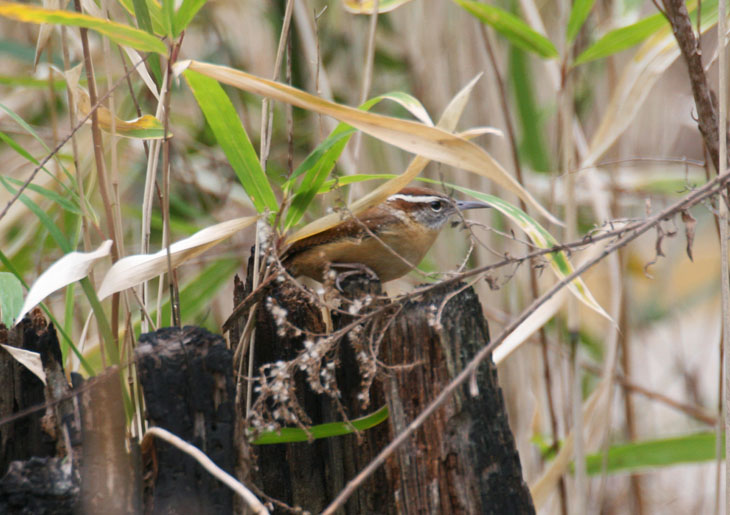
While the birds have been active enough all winter, the breeding season has arrived and countless species could be spotted, flipping through the trees and digging in leaf litter. This Carolina wren (Thryothorus ludovicianus) posed momentarily on a stump for a few frames, then flew off just as I tripped the shutter once more.


Back at the botanical garden, the chorus frogs were in full force, sounding off loudly every time no one was near, but falling silent as soon as anyone closed to visual distance, making it difficult to spot them at all. This one, however, remained floating in a tiny pond, eyes and back just breaking the surface, and I chose this angle solely for the bizarre perspective.
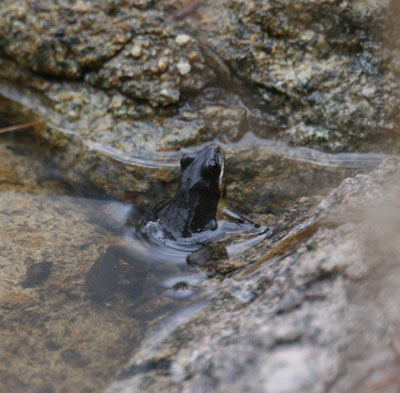 Here, another plays it cool while we were nearby, refusing to reveal its presence any more than it has, which isn’t much. Chorus frogs are quite small, perhaps 5 cm in length, and are easily mistaken for just about anything else in the water. I was only able to spot this one by knowing it would be there.
Here, another plays it cool while we were nearby, refusing to reveal its presence any more than it has, which isn’t much. Chorus frogs are quite small, perhaps 5 cm in length, and are easily mistaken for just about anything else in the water. I was only able to spot this one by knowing it would be there.
I have no better views than this, so I can’t pin down the species adequately – perhaps a southern chorus frog, but more likely an uplands chorus frog (Pseudacris feriarum) – none of them have markings as solid black as they appear in these images, which is mostly due to the overcast lighting of the day, perhaps partially due to the season. I still intend to get better images than these at some point – it’s just a matter of finding a habitat for them that I can stake out, perhaps after nightfall (ruling out all parks in the area.) Meanwhile, if you want to know what the call sounds like, you can go to this post from last year with the embedded sound file.
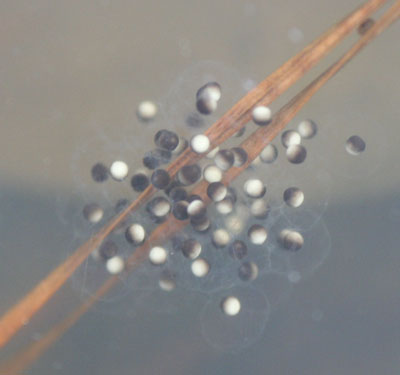 Eggs could be found as well, but only by looking very closely – the bi-colored center of these aren’t much larger than the head of a pin, and that’s pine straw that they’re attached to. Since the botanical garden is much closer to where I live now than last year, I might be able to keep an eye on the development of these – we’ll see. I had also intended to have a pond established on the property by now, but that project hasn’t gone well at all this winter, so it’s unlikely I’ll have the easy access to aquatic subjects that I’d planned to have. The best I can say is watch this space to see what pops up.
Eggs could be found as well, but only by looking very closely – the bi-colored center of these aren’t much larger than the head of a pin, and that’s pine straw that they’re attached to. Since the botanical garden is much closer to where I live now than last year, I might be able to keep an eye on the development of these – we’ll see. I had also intended to have a pond established on the property by now, but that project hasn’t gone well at all this winter, so it’s unlikely I’ll have the easy access to aquatic subjects that I’d planned to have. The best I can say is watch this space to see what pops up.
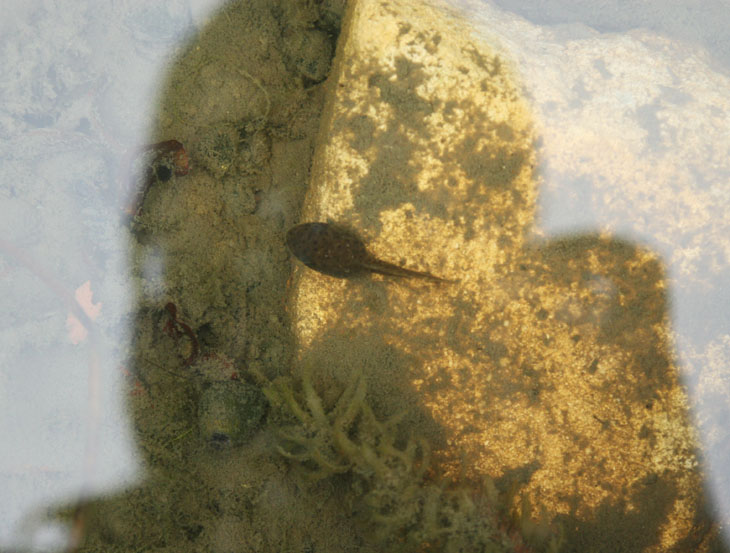
There’s nothing remarkable about this image, but I’m going to use it to illustrate something about shooting aquatic subjects. Just to mention it, but this tadpole is roughly half the mass of the adult frogs seen above, and clearly a different species – probably a bull frog or leopard frog. Sunny days are best when trying to shoot something in the water from above the surface, because the light penetrates. The diffuse light from haze and overcast doesn’t get into the water as well, but worse, it reflects from the surface no matter which way you’re facing, making it seem as if you’re looking through milky glass. The quick fix is seen here.

Granted, you shouldn’t focus on the surface itself, or even what’s reflected in it, but anything that blocks the sky enough to prevent the reflection will permit a better view, and the easiest way to do this is often with your head. If you look very close, you might make out “Canon” spelled backwards across the tadpole…
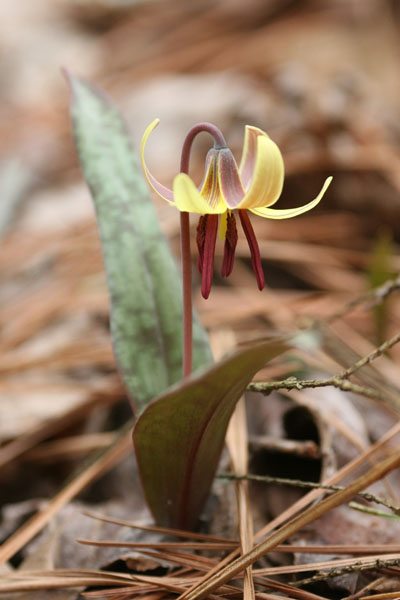 There still isn’t much growing yet, but there were a few trout lilies (Erythronium americanum) peeking out. Not 10 cm high and extremely subtle when viewed from above, I had to get down on my knees, bent almost until my ear touched the ground, to get the details of the flower. This isn’t an old or deformed one – they grow looped over like that, which makes me wonder why, and what kind of pollinator it attracts. Perhaps they’re actually bioluminescent, and serve as kind of a street light for field mice with loose morals to hang around beneath…
There still isn’t much growing yet, but there were a few trout lilies (Erythronium americanum) peeking out. Not 10 cm high and extremely subtle when viewed from above, I had to get down on my knees, bent almost until my ear touched the ground, to get the details of the flower. This isn’t an old or deformed one – they grow looped over like that, which makes me wonder why, and what kind of pollinator it attracts. Perhaps they’re actually bioluminescent, and serve as kind of a street light for field mice with loose morals to hang around beneath…
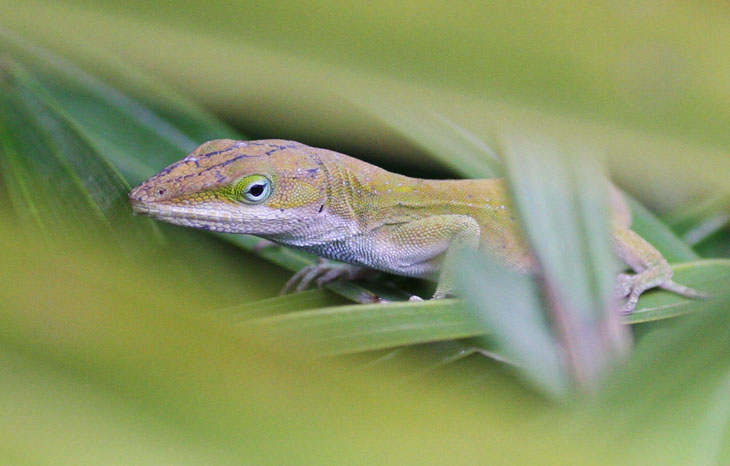
This was one species I was quite surprised to see out so soon – I guess the weather of the past three days has been sufficient to stir them out of dormancy. Green anoles (Anolis carolinensis) are definitely sun-worshippers, and I really didn’t expect to spot any until the insects were a lot more active (for instance, I have yet to see any bees around.) This one we photographed twice, coming back to check on it after our presence caused it to slink out of sight the first time around.
 These images are out of chronological order, and it shames me mightily, I admit it, but they worked better in the layout this way (unless you’re using a smutphone or some other toy to view this site, in which case all bets are off.) I shot this one first, when the reptile was perched more out in the open, and obtained the one above while it had started venturing out but was still utilizing the camouflaging and obscuring fronds of the palmlike thing – I really have to determine the species, because that particular plant has appeared in a lot of my images.
These images are out of chronological order, and it shames me mightily, I admit it, but they worked better in the layout this way (unless you’re using a smutphone or some other toy to view this site, in which case all bets are off.) I shot this one first, when the reptile was perched more out in the open, and obtained the one above while it had started venturing out but was still utilizing the camouflaging and obscuring fronds of the palmlike thing – I really have to determine the species, because that particular plant has appeared in a lot of my images.
I’m still half-expecting the weather to make one last desperate cold-and-miserable spasm before spring truly kicks in, so I’m treating this as a preview and not the main event, but it was still nice to see a little activity. Mid-latitude winters are just not kind to nature photography.




















































